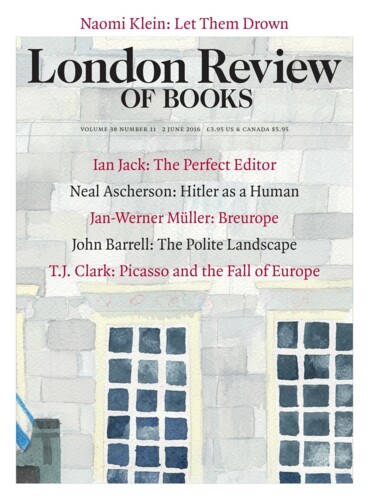For once the difficult architectural layout of the Barbican Art Gallery works in favour of the current exhibition. Strange and Familiar: Britain as Revealed by International Photographers, curated by the English photographer Martin Parr, is made up of around 250 works by 23 photographers who came to Britain for long and short periods between the 1930s and 2014. The division between the two floors of the gallery offers a useful temporal break: the first fifty years upstairs; the later works below. More to the point, the division between the two floors signals an aesthetic break. The pictures on the upper floors, almost all of them in black and white, were conceived for the pages of a magazine or a book, while the works downstairs – most of them in colour and reproduced at a much larger scale – were intended for the gallery wall. Upstairs, most of these earlier pictures tell stories – political, social, domestic – about the people and places they depict. Downstairs a later generation of photographers believes the narrative tropes of photojournalism are something to avoid. (The exhibition closes on 16 June.)
Anybody looking for Britain’s character to emerge from the show is likely to be disappointed. It’s rather a reminder that, with rare exceptions, photographers find what they come looking for. Not that this means the show is a failure. What soon becomes clear is how much the UK has been read through its social groups: royalty and the aristocracy in the south, working and industrial classes to the north and west. The upstairs downstairs divide is still deeply ingrained and over the years visiting photographers have only reinforced the national stereotypes: the nanny, the butler, the toff, the man in the bowler hat, the black-faced miner, the snot-nosed child, the woman in rollers and a headscarf, the brass band, the council estate, the corner shop, each one as emblematic as the Union Jack and the London bus.
The German-born photographer Evelyn Hofer came to London in the early 1960s to make a series of portraits of the city and its people for V.S. Pritchett’s book London Perceived. Her subjects stand or sit patiently for her camera, willing but unsmiling, recalling, though without quite the same compositional rigour, the portraits of August Sander, which she knew and admired. Her Crossing Guard portrays solid reliability in her (yellow?) calf-length coat and peaked cap, her lollipop sign held upside-down at her side. The Bus Conductress and Postman, taken in 1977, might have stepped out of Sander’s taxonomy, People of the 20th Century, were it not for their local insignia.
Henri Cartier-Bresson, for the purposes of this exhibition, is cast as a royal reporter. In 1937, his first year working for the French communist daily Ce Soir, he covered the coronation of George VI, turning his back on the royals to capture the event through the reactions of the crowd. He was back for Ascot in 1953, for Churchill’s funeral in 1965, for Princess Anne’s wedding in 1973, and the queen’s silver jubilee in 1977, but nothing here has either the lightness or the precision of his best pictures. As with other photographers in this show, notably Garry Winogrand, what could be done with ease and subtlety at home was harder to achieve abroad.
Robert Frank worked in Britain between 1951 and 1953. Born in Switzerland but based in New York, he was still half-hoping his pictures would appeal to a magazine like Life but at the same time he was trying, as he wrote, to ‘break from the Traditional … trying to forget easy photo, trying to make something coming from within’. Yet Frank, too, sees the country through divisions of class: the City is a place of bowler and top hats, rolled umbrellas and canes. London is lyrically subsumed in fog. Only in Wales, in 1953, does he seem to relax and let his camera roam in a chiaroscuro sequence of blackened faces and bleak landscapes and into a miner’s home.
Photographers who arrived in Britain without an agenda are refreshing. The Chilean Sergio Larrain, for example, who came to London on a British Council grant in 1958-59, could make a picture out of an empty office with its sea of desks and phones, or the landscape of terraces seen from a train window. He noticed the unwitting choreography of people moving through the streets. The Italian Gian Butturini caught London at the tail end of the 1960s in a series of high-contrast, grainy black and white shots of anti-Vietnam demonstrators, as well as homeless people and a few stray hippies, putting it all together with a poem by Allen Ginsberg in a self-published book. Rineke Dijkstra’s large-format full-length portraits of girls in Liverpool in 1995 announce a sudden shift in scale. Dressed for a night out at the Buzz Club they stand fidgety and self-conscious, not sure what they will unwittingly disclose.
By the later stages of the show, as David Chandler points out in his catalogue essay, Britain was often just a stopover for those intent on creating an international body of work in which their own style was paramount. Sometimes their subjects are its victims. The American Bruce Gilden manages to find a number of his typical close-cropped grotesques at West Bromwich bus station and on the streets of Essex. The Dutch photographer Hans Eijkelboom surreptitiously (shutter release hidden in his pocket) adds shoppers in the Bullring in Birmingham to his ever expanding mail-order-style catalogue of 21st-century types. In an era of globalisation, the works of these later photographers, Chandler writes, ‘often suggest similarities and continuities between cultural contexts as much as localised differences’. They took from Britain what they needed.
Send Letters To:
The Editor
London Review of Books,
28 Little Russell Street
London, WC1A 2HN
letters@lrb.co.uk
Please include name, address, and a telephone number.


